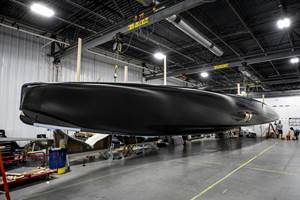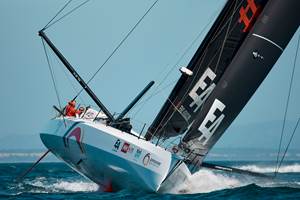The first fully-infused boat hull in India a success
DIAB's Composites Consulting Group (CCG) assists Aquarius Fibreglas in designing the infusion of a 15.6m fast interceptor craft.
Aquarius Fibreglas, located in Goa, India, is the first Indian boat manufacturer to develop a fully infused vessel. Featuring a DIAB Group (Laholm, Sweden) sandwich core, the vessel is a 15.65m Fast Interceptor Boat. Composites Consulting Group (CCG, Laholm, Sweden), an independent DIAB Group company, offered Aquarius a full onsite build to ensure the full value of composite design was realized.
The marine industry in India has traditionally been dominated by steel and alloy constructions. But there are exceptions. Aquarius Fibreglas, founded in 1995 by Ratnakar Dandekar, prefers building boats in advanced composites. Aquarius started out by working in partnership with well-established naval architects outside of India. However, it didn't take long before this ambitious shipyard moved on to making its own designs and constructions. Dandekar was well aware of the resin infusion process and its benefits for advanced marine composite builds, but to introduce resin infusion to his shipyard, he contacted CCG, who he knew had extensive experience in this field. After some initial discussions with Rimzath Ali from CCG , Aquarius decided to try the process of vacuum infusion for an 8m cruise boat. Dandekar hoped that this would prove that boats built with vacuum infusion technology could be a reality in India.
In the third quarter of 2014, Aquarius shipyard won a contract to design and build a series of 15.65m Fast Interceptor Boats with top speeds of 35 knots and meeting DNV GL standards. The boats would be built in India and delivered overseas for coastal patrol and interception work. Again, Aquarius contacted CCG for help with designing the structural engineering of the vessel in order to meet the GL-required classification. This was a key area as CCG also had the knowledge of how to engineer the vessel to guarantee a successful infusion process.
The core materials were delivered in early January 2015 and the building process itself started on January 23. Over a period of two weeks the staff at Aquarius, under the guidance of CCG, set up and successfully infused the hull, followed by the deck and bulkheads. The new technique meant that no plywood was used in the building process. All areas requiring bolting or fixings used high-density DIAB core instead. The core is about half the weight of plywood but offers the same or better compressive strength and has great screw retention qualities.
“This was a difficult first build as the entire hull was infused in one piece," said Todd Henry, Asia Region manager at CCG. “The staff was extremely careful with the accuracy of the core fitting and the placement and overlapping of the fibers, ensuring the structural design was carried out exactly as the plan dictated. This is never easy and yet I went away very satisfied with the task completed and knowing Aquarius is ready to continue on its own.”
Aquarius Fibreglas is now preparing to build the remaining 10 boats and CCG will continue to offer support when and where needed. CCG's Ali commented, “We hope that the efforts taken here by Aquarius will encourage others in the marine market in India to use this technology and show that we can build as good a product as anyone else.
Read more about Aquarius Fibreglas: http://www.aquariusgoa.com/
Related Content
Al Seer Marine, Abu Dhabi Maritime unveil world’s largest 3D-printed boat
Holding the new Guinness World Record at 11.98 meters, the 3D-printed composite water taxi used a CEAD Flexbot to print two hulls in less than 12 days.
Read MorePro-Set named official materials supplier for New York Yacht Club American Magic
Competitive sailing team prepares for the 37th America’s Cup beginning in August 2024 with adhesives, resins and laminate testing services for its AC75 monohull construction.
Read MoreOrbital Composites installs robotic AM system at University of Rhode Island
The 12-axis Orbital S system designed to print continuous fiber-reinforced parts will be used to advance research in composites for underwater unmanned vehicles.
Read MoreRefurbished Einstein yacht demonstrates innovative composites repair and redesign
Years of creative engineering work went into resurrecting the composites-intensive IMOCA 60 racing yacht — with award-winning results.
Read MoreRead Next
Modeling and characterization of crushable composite structures
How the predictive tool “CZone” is applied to simulate the axial crushing response of composites, providing valuable insights into their use for motorsport applications.
Read MorePlant tour: A&P, Cincinnati, OH
A&P has made a name for itself as a braider, but the depth and breadth of its technical aptitude comes into sharp focus with a peek behind usually closed doors.
Read MoreCFRP planing head: 50% less mass, 1.5 times faster rotation
Novel, modular design minimizes weight for high-precision cutting tools with faster production speeds.
Read More
























